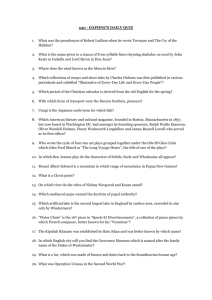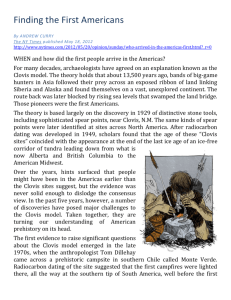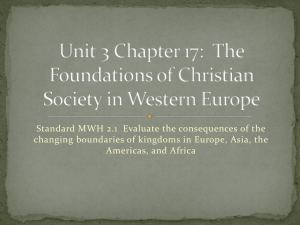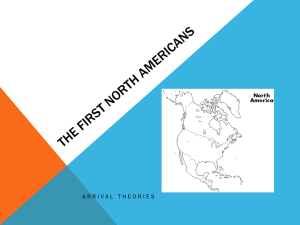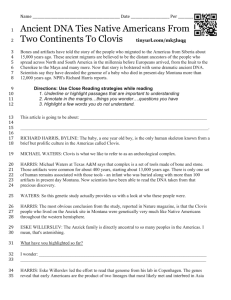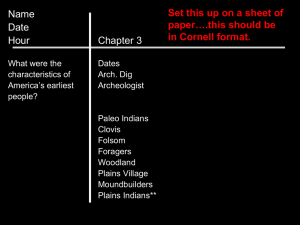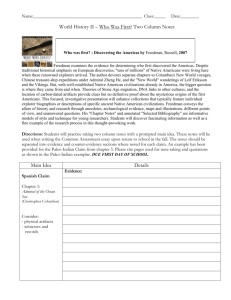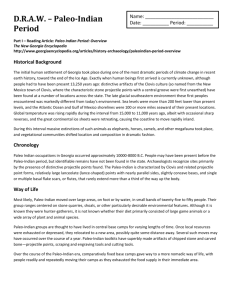File
advertisement
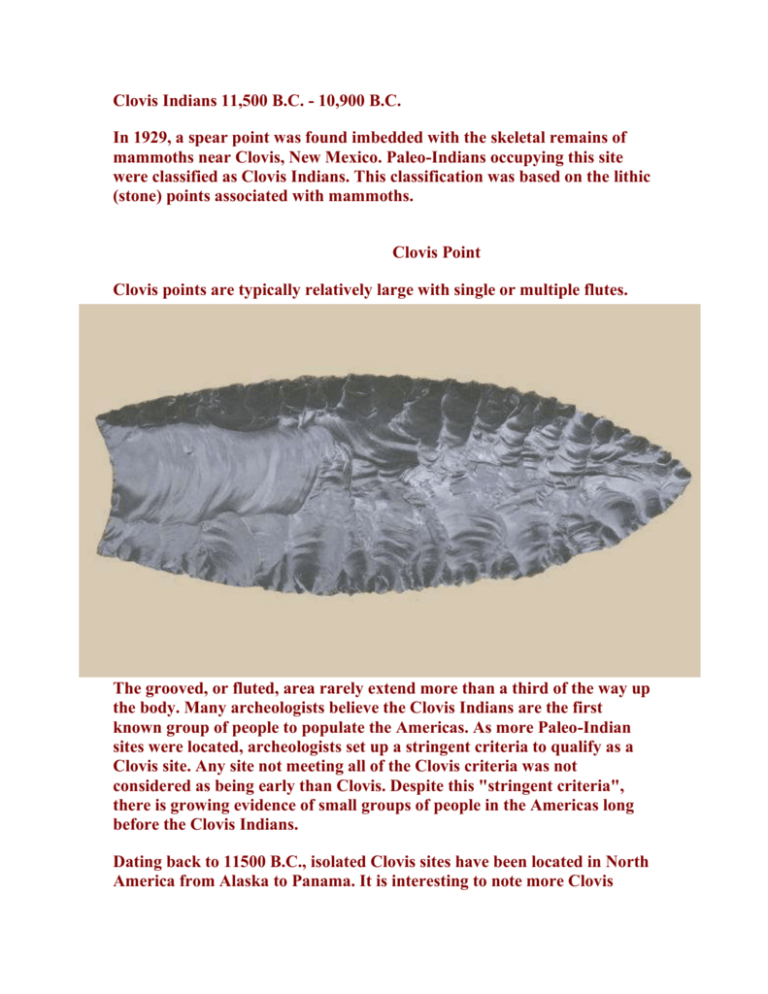
Clovis Indians 11,500 B.C. - 10,900 B.C. In 1929, a spear point was found imbedded with the skeletal remains of mammoths near Clovis, New Mexico. Paleo-Indians occupying this site were classified as Clovis Indians. This classification was based on the lithic (stone) points associated with mammoths. Clovis Point Clovis points are typically relatively large with single or multiple flutes. The grooved, or fluted, area rarely extend more than a third of the way up the body. Many archeologists believe the Clovis Indians are the first known group of people to populate the Americas. As more Paleo-Indian sites were located, archeologists set up a stringent criteria to qualify as a Clovis site. Any site not meeting all of the Clovis criteria was not considered as being early than Clovis. Despite this "stringent criteria", there is growing evidence of small groups of people in the Americas long before the Clovis Indians. Dating back to 11500 B.C., isolated Clovis sites have been located in North America from Alaska to Panama. It is interesting to note more Clovis points have been found east of the Mississippi than west of the Mississippi, but many of these points could have been carried there by other Indians...the only way to date a stone point is its association with an organic substance i.e. a wooly Mammoth. Pennsylvania Paleo-Indian Tools Obsidian (2007) Flaked The Paleo-Indian tool picture is taken from the Pennsylvania Archeology web page, which is an excellent site. These pictures are used to demonstrate a real problems with dating sites based on "tools", and is one of the reasons some archeologist reject pre-Clovis sites based on the type of "tools" found. Using pieces of flint as knives or scrapers does not mean they were chipped by Indians. The natural flaking of obsidian results in sharp pieces, even with "thumb or finger grooves". The flaked obsidian pictured above was picked up off the ground near Kilgore, Idaho last summer. The next paragraphs is paraphrased from the Pennsylvania Archeological website. Meadowcroft Rockshelter in Washington County, Pennsylvania dates to at least 16250 B.C. and contains artifacts similar to those found in Siberia from the same time period. The fluted Clovis point has not been found at Meadowcroft or in Siberia. Other sites with early dates are: Cactus Hill in Virginia 16200 B.C., Topper in South Carolina 16000 B.C., and Monte Verde in Chile 12500 B.C.. These sites represent evidence of an early migration. Because there are so many sites dating to the period from 11500 B.C. to 10900 B.C., it is hard to imagine Clovis Indians appearing so quickly without a Pre-Clovis population in place. The age of "tools" found in archeological sites is based on the level of the dig and other material at the same level i.e. charcoal...but maybe the charcoal was washed or blown into the wind-water-formed shelter from a forest fire 16,000 years ago. There are hundreds of Clovis sites in North America, but only a few sites supposedly pre-date the Clovis Period. Alternate Pre-Historic Indian Routes - Anthropik Network Living in small hunter-gatherer bands, the Clovis Indians followed primarily herds of mammoth and mastodon for about five hundred years, and then according to some archeologists, abruptly disappeared. The Clovis disappearance coincided with the mass extinction of the Ice Age animals, such as the mastodon and wooly-haired mammoth. It has been postulated by these archeologists over hunting by Clovis Indians contributed to this mass extinction of Ice Age animals. Some points to consider for over hunting causing this mass extinction: 1). The Pennsylvania Archeological site states: there are hundreds of welldated sites in both North and South America that date to between 11,500 and 10,500 years ago. Most of these sites contain spear points with a flute, or channel along its length; in the eastern United States, these points are most often called Clovis points. 2). The North American Clovis Indians lived as hunter-gatherers in small bands of twenty to sixty extended family members on the fringe of the Great Plains, not out on it (Haines). On average, a family group consisted of eight members with two warriors. For the sake of argument, lets say several hundred sites are increased to a thousand sites by future discoveries, and ninety percent of these sites are in the southwestern United States. Using the highest figure, this put the total number of PaleoIndians scattered across North America at approximately sixty thousand with fifty-four thousand in the southwest. Of this fifty-four thousand, twenty percent are hunters, which means there were about ten thousand hunters...the point is, no matter how the figures are juggled, there were very few Paleo-Indians, or anybody else, even on the fringes of the Great Plains between 11500 B.C. and 10500 B.C. 3) The large grass-eating animals lived on the Great Plains...Indians lived on the edge of the Great Plains. With ten thousand Paleo-Indian hunters roaming east of the Rocky Mountains between Canada and East Texas, it is a stretch of the imagination to think Paleo-Indians had much effect on the "Overkill" of anything, especially Ice Age animals...or...any people whose ancestors survived the walk from Siberia to central Texas are going to abruptly starve to death when there was plenty of other animals to hunt. Did the Clovis Indians disappear, or did they adapt a new lithic point and become classified as Folsom Indians?
